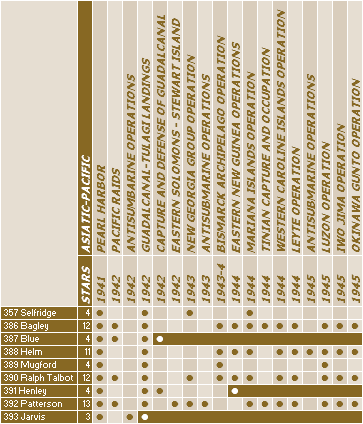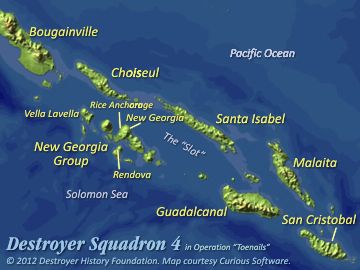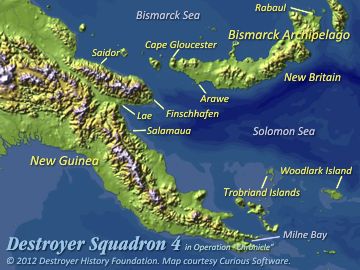
Caution: The purpose of this essay is to identify operations for which service stars were earned as indicated in the accompanying table. It has been compiled from secondary sources such as the Dictionary of American Fighting Ships which, in most cases, are silent about squadrons and divisions. Some statements, particularly regarding the dates of organization changes, reflect educated guesses. Verification will require examination of records such as war diaries and deck logs.
The squadron was present at Pearl Harbor when the Japanese attacked on 7 December 1941. Later that month, it screened RAdm. Frank F. Fletcher’s Saratoga task force with cruisers Minneapolis, Astoria and San Francisco during the aborted relief of Wake Island. Four DesRon 4 destroyers also participated in sorties in February-March 1942:
In June, the squadron was transferred to Australia, where it joined cruisers HMAS Australia, Canberra and Hobart and USS Chicago in forming Task Force 44 under RAdm. Victor A.C. Crutchley, RN. In August, this force—as Task Force 62.2—led the landings at Guadalcanal that commenced Operation “Watchtower.”
On the night of 9 August, a Japanese cruiser force closed Guadalcanal and, at the Battle of Savo Island, surprised Allied cruisers and destroyers protecting transports anchored offshore. In this action:
World War II Operations of the destroyers
originally attached to Destroyer Squadron 4 
On 21–22 August, Blue, Helm and Henley were screening the transport area when Japanese destroyer Kawakaze surprised and torpedoed Blue. She was scuttled the next day.
During the Battle of the Eastern Solomons on the 24th, Selfridge was attached to RAdm. Leigh Noyes’ Task Force 61.3 with destroyers of DesDiv 15 and DesRon 12 screening Wasp.
During the remainder of 1943, the squadron operated on both axes of Operation “Cartwheel,” the advance toward Rabaul.
Ralph Talbot and Patterson were active in Operation “Toenails,” the New Georgia campaign:

DesRon 4 in Operation “Toenails,” June–December 1943.

DesRon 4 in Operation “Chronicle,” July–December 1943.
Meanwhile, operating with MacArthur’s Seventh Fleet from Milne Bay up the New Guinea coast toward the Bismarck Sea in Operation “Chronicle,” Bagley, Helm and Mugford supported the invasion of Woodlark Island in July 1943, conducted shore bombardment and patrols in August, and escorted LSTs for the landing at Lae on 4 September. Later that month Henley and Mugford supported the seizure of Finschhafen where, on 3 October, submarine RO-108 torpedoed and sank Henley.
On 20 October, Bagley and Mugford were escorting auxiliaries there when 60 enemy aircraft from Rabaul attacked. Neither was hit. In December, these two destroyers advanced to New Britain for landings at Arawe on the 14th. On the 26th, they plus Helm and Ralph Talbot did it again at Cape Gloucester. They continued on to Saidor in January 1944.
In their place, the four destroyers of DesDiv 12 (DesRon 6)—Dunlap, Fanning, Case and Cummings—plus Lamson were reassigned as DesDiv 7 while Cassin and Downes from DesDiv 5, Ellet, most recently from DesRon 2, plus ex-DesRon 11 flagship Roe from the Atlantic formed the new DesDiv 8.
Operating from the Marianas on the 9 October, Cassin and Downes screened heavy cruisers Chester, Pensacola and Salt Lake City in bombarding Marcus Island as a diversion for a raid on Formosa, and then joined Task Group 38.1 for strikes on the Philippines in conjunction with the invasion of Leyte beginning on the 18th.
Operating from Ulithi in November, Case bombarded Iwo Jima and, on the 20th rammed and sank a Japanese midget submarine at Ulithi’s Mugai Channel. On 24 December, while bombarding Iwo Jima, Case and Roe sank a Japanese transport. They returned to Iwo Jima in January for antisubmarine patrol during the landings and remained in the area on antisubmarine patrol, air-sea rescue and radar picket duty until the close of the war.
On 19 June 1945, Dunlap sank an enemy craft attempting to evacuate Chichi Jima and picked up 52 survivors. She returned there on 31 August to host the surrender of the Bonin Islands.
Sources: Morison, Rohwer, Roscoe, Hyperwar: United States Fleet Pacific Organization, 1 May 1945; Naval History & Heritage Command including Dictionary of American Naval Fighting Ships histories for individual ships.